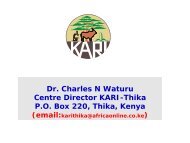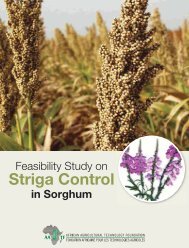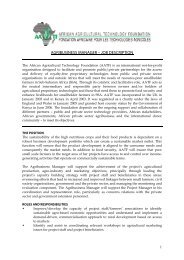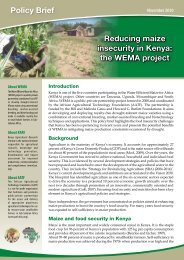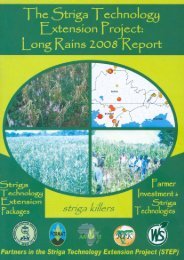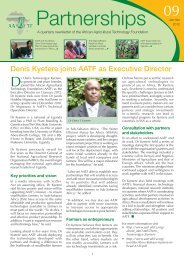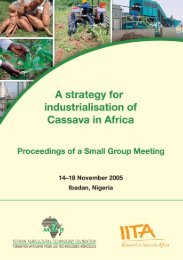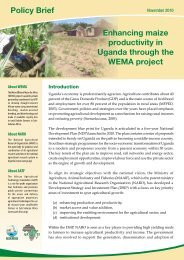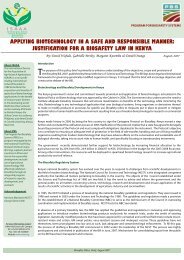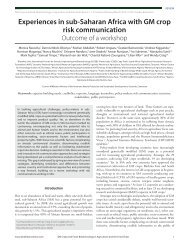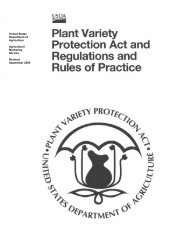Baseline Study of Striga Control using IR Maize in Western Kenya
Baseline Study of Striga Control using IR Maize in Western Kenya
Baseline Study of Striga Control using IR Maize in Western Kenya
You also want an ePaper? Increase the reach of your titles
YUMPU automatically turns print PDFs into web optimized ePapers that Google loves.
3.2.1 Fertiliser and pesticidesFarmers apply <strong>in</strong>organic fertiliser and pesticides to their crops, especially maize. Results <strong>in</strong>Table 3.2 <strong>in</strong>dicate that few respondents used <strong>in</strong>organic fertiliser dur<strong>in</strong>g the two grow<strong>in</strong>gseasons under study. In Nyanza prov<strong>in</strong>ce, only eight farmers reported on fertiliser applicationdur<strong>in</strong>g the 2005 long ra<strong>in</strong>s. More farmers (25%) <strong>in</strong> <strong>Western</strong> prov<strong>in</strong>ce applied fertiliser to theirmaize. Dur<strong>in</strong>g the short ra<strong>in</strong>s, fewer farmers <strong>in</strong>vest <strong>in</strong> <strong>in</strong>organic fertiliser. The rates <strong>of</strong>fertiliser applied to maize are also very low: about one 50 kg-bag per ha for Nyanza and two50-kg bags for <strong>Western</strong> dur<strong>in</strong>g the long ra<strong>in</strong>s. These quantities would correspond to about13kg N/ha for Nyanza and 26kg N/ha for <strong>Western</strong> for the most commonly commercialisedcompound fertiliser, Calcium Ammonium Nitrogen (CAN) <strong>in</strong> the ratio 26:0:0. <strong>Maize</strong> <strong>of</strong>tenrequires rates <strong>of</strong> 90 to 120kg N/ha to expect good yields <strong>of</strong> about 4–6tons/ha. The quantitiesapplied <strong>in</strong> western <strong>Kenya</strong> are just symbolic. The quantity <strong>of</strong> fertiliser applied to other crops iseven worse than that <strong>of</strong> maize.Table 3.2. Fertiliser and pesticide use <strong>in</strong> western <strong>Kenya</strong>Long ra<strong>in</strong>s 2005 Short ra<strong>in</strong>s 2004Nyanza <strong>Western</strong> Nyanza <strong>Western</strong>Inorganic fertiliser <strong>in</strong> maize (kg/ha) 53.3 (8) 97.0 (109) 38.8 (4) 84.0 (61)Inorganic fertiliser <strong>in</strong> other crops (kg/ha) 34.6 (8) 55.1 (22) 32.6 (10) 22 (10)Pesticide <strong>in</strong> maize (l/ha) 3.7 (10) 0.9 (30) 0.9 (7) 0.2 (14)Pesticide <strong>in</strong> other crops (l/ha) 1.4 (26) 2.3 (43) 1.2 (21) 3.1 (31)Figures <strong>in</strong> brackets represent number <strong>of</strong> respondentsThe proportion <strong>of</strong> farmers who applied pesticides <strong>in</strong> post harvest to protect the produce (suchas Skana or Sp<strong>in</strong>to dust aga<strong>in</strong>st weevils <strong>in</strong> maize gra<strong>in</strong>s) is also m<strong>in</strong>imal. In contrast t<strong>of</strong>ertiliser rates for maize, the doses used for pesticides seem to be optimal (at least for the2005 long ra<strong>in</strong>s), provided that the <strong>in</strong>formation given refers to the pure chemical before itsdilution. In summary, there is little done to <strong>in</strong>vest <strong>in</strong> external <strong>in</strong>puts for the purpose <strong>of</strong> the<strong>in</strong>tensification <strong>of</strong> crop production.3.2.2 Seed useThe results are shown for Nyanza prov<strong>in</strong>ce only (Table 3.3) s<strong>in</strong>ce the patterns <strong>in</strong> seed use for<strong>Western</strong> prov<strong>in</strong>ce are similar. Quantity <strong>of</strong> seed used (kg/ha) does not <strong>of</strong>ten comply with therecommendations by extension services. For maize, the prov<strong>in</strong>cial average <strong>of</strong> 34kg/ha dur<strong>in</strong>gthe 2005 long ra<strong>in</strong>s is higher than 25kg/ha recommended for this crop. In Siaya, the quantitiessown for maize were almost double the recommendations. In Kisumu, it was the oppositewith less than 50% <strong>of</strong> recommendations. The comments made for maize also apply to othercrops (Table 3.3). This shows that farmers do not sow the quantities <strong>of</strong> seed required toobta<strong>in</strong> an optimal occupation <strong>of</strong> the field by the crop. A lower density <strong>of</strong> plants does not payback on the <strong>in</strong>vestments made to open up a new field and to optimise the utilisation <strong>of</strong> soilnutrients by crops. A higher density leads to overexploitation <strong>of</strong> natural resources andcompetition <strong>of</strong> crops. In both situations, the result<strong>in</strong>g crop productivity can only be low. Thefield management <strong>of</strong> a new crop technology (such as <strong>IR</strong> maize) is as important as the geneticmaterial itself.22



